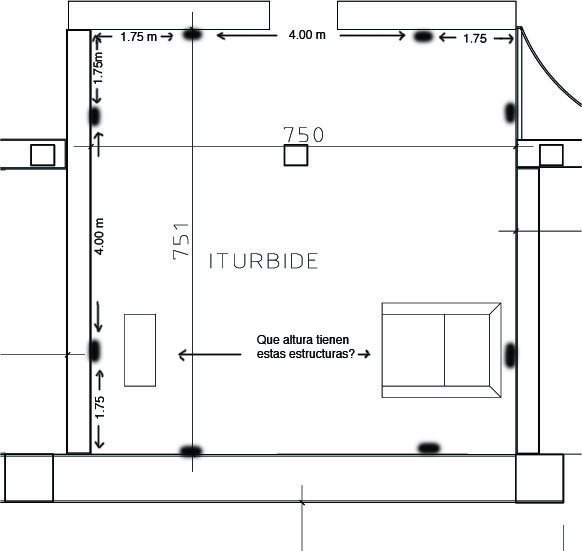
|
El Eco Esta en Todas Partes - The Eco is Everywhere
JUMEX Collection. Mexico 2003
Obra sonora para 8 pistas digitales - Sound work for eight digital tracks
El Eco - Stereo excerpt
If we could talk about an acoustic hive, my sound installation is one that was originally created for the 25 by 27 meters space square at the Colección Jumex quarters in Mexico City. Yet, at the same time, it is a virtual acoustic system that interconnects different sound spaces around the world. In this case, the earth, the home where we all inhabit represented by the hive.
According to Marshall Macluhan, electronic technology gets the occidental man out of his thinking based in vision (controlled by the left hemisphere of his brain) that works with a causal and sequential logic, and puts him in a new acoustic dimension(Our right brain hemisphere controls our hearing, and all the non-linear ways of perceiving the world that will be explained here ) where he can be at different points of the planet at the same time. This rational man stops being isolated in his own town or city, and stops being one-centered becoming then multi-centered.
Our ear listens in a ratio of 360 degrees, while our sight perceives only in a frontal way. The new acoustic space in which we live is holistic, simultaneous, emotional, qualitative and receptive. The defined figure, concrete element in which the occidental man concentrated in, becomes now an integral part of the background, and fuses or sometimes dissolves in it. The background is acoustic, not visual, and in its complexity we change our perceptive concentration from one place to the other in a constant way, like when we listen chance music by John Cage or a moment in the middle of the a soundscape where multiple simultaneous aural elements occur.
The idea of this installation is to create backgrounds starting from recordings of soundscapes that I have made in different places of the planet. These backgrounds are always multi-centric, because not specific figures (or specific sound objects) predominate in them. The backgrounds are equivalent to the honeycombs of a beehive, the walls of this precinct. Then, I try to inter-connect these different non-linear settings that are manifested in complex simultaneous structures, by way of linear sounds that simulate communication sound codes of living creatures. Curiously, a beehive is designed in such a way that the air passes and ventilates the internal space. These passages constitute the circulation sound channels where the sounds figure get around, forming the sound lines of the work that eventually integrate with the background soundscapes. This integration becomes also possible because many of these electronic sounds resemble sounds of birds and insects that could actually be part of those environments.
Although we live at present in a new electronic acoustic space, many of us have not realized this in a conscious way. It is then necessary to adopt a new attitude in the sequential and simultaneous perception of figure and background, and towards the understanding of the present technological world by way of finding a new balance between our two brain hemispheres that control our perceptual vision and hearing.

Installation diagram at the exhibition La Colmena, Jumex Collection 2003
Si podemos hablar de una colmena acústica, mi obra es
una colmena que abarca el cuadrado de 25 * 27 metros de la Colección
Jumex, pero al mismo tiempo es un sistema acústico virtual que inter-conecta
diversos espacios sonoros del planeta. Es decir, en este caso la colmena representaría
la tierra, la casa en la que todos habitamos.
De acuerdo a Masrhall Macluhan, la tecnología electrónica saca
al hombre occidental de su pensamiento basado en lo visual (controlado por el
hemisferio izquierdo del cerebro) que funciona con una lógica causal
y secuencial, para meterlo en una nueva dimensión acústica en
la que puede estar en varios lugares del planeta al mismo tiempo. Este hombre
racional deja de estar aislado en su pueblo o ciudad, deja de ser uni-céntrico
y se convierte en multi-céntrico.
El oído escucha en un radio de 360 grados, mientras que la vista percibe
solo de manera frontal. El nuevo espacio acústico en el que vivimos es
holístico, simultaneo, emocional, cualitativo y receptivo. La figura
definida, elemento concreto en el cual el hombre occidental se concentraba,
pasa ahora a integrarse con el fondo, y a confundirse o a desaparecer muchas
veces en el. El fondo es acústico, no visual, y en su complejidad cambiamos
nuestra concentración perceptiva de un lugar al otro de manera constante,
como cuando escuchamos la música aleatoria de John cage o un momento
sonoro del medio ambiente con múltiples elementos auditivos simultáneos.
La idea de esta composición-instalación es crear fondos a partir
de grabaciones de paisajes sonoros que he realizado en distintos lugares del
planeta, estos fondos son siempre multi-centricos, ya que ninguna figura específica
(u objeto sonoro específico) predomina en ellos. Los fondos son equivalentes
a los panales de una colmena, a los muros de este recinto. Luego, intento inter-conectar
estos distintos fondos no lineales que se manifiestan en complejas simultaneidades,
por medio de sonidos lineales que simulan códigos de comunicación
sonora electrónica, y que se confunden con los códigos de algunos
seres vivientes del reino natural. Curiosamente, una colmena esta diseñada
para que el aire pase y ventile todo el espacio interno. Estos pasajes son los
canales de circulación por los cuales transitaran estos sonidos figura,
líneas sonoras de la obra que se integran eventualmente a los paisajes
fondo, ya que muchos de estos sonidos electrónicos son curiosamente parecidos
a los sonidos de las aves y de los insectos.
Pese a que vivimos en un espacio acústico nuevo, muchos de nosotros ni
siquiera nos hemos percatado de ello. Es necesario entonces adoptar una nueva
actitud en la percepción secuencial y simultanea de figura y fondo, así
como en la comprensión del mundo tecnológico actual, a partir
de la búsqueda de un nuevo equilibrio de nuestros dos hemisferios cerebrales.